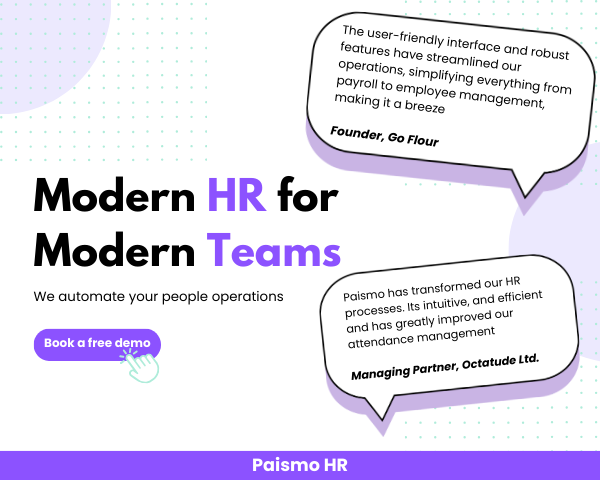Highlights
- OTE shows how much employees can earn by meeting targets and combining base salary and performance-based commission.
- It's widely used in sales roles but is also growing in other performance-driven job types.
- Capped OTE limits earnings, while uncapped OTE offers unlimited potential based on results.
- Calculating OTE is simple: add base salary to commission earned at full target.
Have you ever encountered the term OTE on a job posting or pay slip and felt unsure about its meaning? Many job seekers ask what does OTE mean, especially when applying for roles with sales targets or performance bonuses. OTE stands for On-Target Earnings, showing how much an employee can earn by meeting expected goals. Moreover, for companies using employee management software, OTE supports fair and competitive pay structures that align with performance.
In this article, we’ll clearly explain what OTE includes, how it works, and why it matters to employers and employees.
What Does OTE Mean in Sales?
In sales, OTE stands for On-Target Earnings, which is the total expected income if a salesperson meets all their goals. It includes a fixed base salary plus a commission tied to performance. However, it’s not guaranteed. Your income depends on how well you perform, and the company’s targets are realistic. For example, a hybrid sales role might offer a 200,000 OTE, with 100,000 as a base salary and 100,000 as possible commission. If you hit your targets, you earn the full amount. If you exceed them, your earnings can increase even more.
Today, many companies use HR software in Pakistan to track sales performance and manage targets in real time. So, this approach keeps managers and sales teams aligned and ensures everyone knows what to expect.
What does OTE Mean in Salary?
OTE stands for On-Target Earnings. It shows how much you can earn if you meet all your work targets. This includes a fixed base salary plus a bonus or commission. OTE is often used in sales jobs, but some startups and growing teams use it in other roles. It helps show a job's full earning potential.
For example, imagine a role offering an OTE of 150,000. In this case, this could mean a base salary of 90,000 and a potential 60,000 in commissions. So, if you meet your targets, you earn the full amount. On the other hand, missing goals may leave you with just the base pay.
What are the Benefits of OTE?
OTE offers more than just a salary range. In fact, it gives employees clear targets, supports strong performance, and helps keep motivation high. As a result, here are the key benefits of using an OTE model:
1. Increases Motivation
OTE directly links pay to performance. That’s why employees work with purpose when they know they can earn more by reaching targets. In the end, this setup creates a natural drive to hit goals and exceed expectations.
2. Boosts Productivity
Since bonuses and commissions depend on results, employees focus on tasks that matter most over time. They spend less time on low-value work and more time on winning deals. Over time, this leads to higher output and faster sales cycles.
3. Improves Employee Engagement
When team members see their efforts lead to real rewards, they feel more connected to their work. This connection builds ownership, confidence, and long-term commitment. For many employees, it stands out as one of the best perks at work.
4. Attracts Skilled Talent
Top performers are drawn to roles where hard work leads to higher pay. A firm OTE offer shows candidates exactly what they can earn. As a result, it helps your company stand out in a crowded job market.
5. Builds a Results-Driven Culture
OTE rewards what matters: outcomes. It creates a work environment where effort and success go hand in hand. Rather than focusing on tenure, teams focus on performance, which boosts growth.
6. Supports Smarter Planning
With HR Automation, managing OTE becomes easier and more reliable. It helps standardize pay plans, align compensation with performance, and reduce manual work. This makes it easier to scale while staying consistent.
What Is the Difference Between Capped and Uncapped OTE?
When setting On-Target Earnings (OTE), companies choose between capped and uncapped commission. A capped OTE limits how much an employee can earn in commission, while an uncapped OTE allows unlimited earnings based on performance. Each option works best depending on your business goals, budget, and team structure. Let’s see their pros and cons:
Capped OTE (With Earning Limits)
Here’s a quick look at why capped OTE appeals to many businesses.
Pros
- Predictable earnings: With a capped plan, employees know their maximum potential income. This helps employers manage budgets more easily and reduce unexpected payouts.
- Less pressure to overperform: Reps experience less stress when they don’t have to chase unlimited targets every month.
- Improved teamwork: Since earnings are capped, team members are more likely to support each other than compete for higher commissions.
Cons
- Lower motivation: Once employees hit their cap, they may stop pushing for more sales since no extra financial reward exists.
- Limited income for top performers: High achievers might feel held back and start looking for better opportunities with more earning potential.
- Talent retention issues: Employees who value performance-based pay may leave for roles with uncapped earnings.
Uncapped OTE (No Earnings Limit)
Here are the top reasons uncapped OTE appeals to high achievers:
Pros
- Unlimited earning potential: Employees stay motivated to sell more because their commission grows with each deal.
- Attracts high performers: Skilled salespeople often prefer roles where their hard work directly increases their income.
- Drives stronger results: With no limits, reps are encouraged to close more deals and outperform their goals.
Cons
- Income instability: If sales drop, reps may earn less, especially if their base salary is low.
- Risk of burnout: Employees might overwork themselves to chase high commissions, leading to stress and exhaustion.
- Budgeting becomes harder: When top performers exceed expectations, it can increase payout costs and make financial planning more difficult.
How Do You Calculate OTE?
To calculate On-Target Earnings (OTE), you can use a simple and clear formula:
OTE = Base Salary + Commission (at 100% of Target)
This formula gives you a good idea of what a sales rep will earn when they meet their full sales goal. While some companies add bonuses or tiered commissions, this is the basic way to calculate it.
Let’s go through two quick examples to make it easier to understand.
Example 1: 50/50 Pay Mix
Suppose a sales rep gets:
- A base salary of $50,000
- A commission of $50,000 when they reach their sales goal
In this case, their OTE is $100,000.
If the rep only meets half the target, they’ll earn:
$50,000 base + $25,000 commission = $75,000 total
Example 2: Monthly Quota with Commission Rate
Now take a rep with:
- A $30,000 base salary
- A $40,000 monthly sales quota
- A 5% commission rate
Each month, they earn $2,000 in commission ($40,000 × 5%).
In a year, that adds up to $24,000.
So their OTE becomes $30,000 + $24,000 = $54,000.
Summary
Knowing what does OTE mean helps employees understand their full earning potential and keeps performance at the center. Whether capped or uncapped, it’s easy to calculate and customize. Moreover, the real-life examples from AEs, SDRs, and marketing leaders show just how flexible and motivating OTE can be across different roles.
FAQs
What Does OTE Mean?
OTE, or On-Target Earnings, refers to the total expected pay when you meet all your performance goals. It combines your base salary with any bonuses or commissions tied to targets.
What Does OTE Mean In Sales?
In sales, OTE means your expected total pay when you hit your targets. It includes your base salary plus sales commission.
What Does OTE Mean In Salary?
OTE in salary outlines the complete compensation you can earn in a year. It adds your base salary to extra earnings like commissions, as long as targets are met.
What Does OTE Mean In Wages?
When it comes to wages, OTE shows your potential income based on performance. It reflects both the steady paycheck and any bonus or incentive pay you could earn.
Become a part of the Paismo community
Paismo is an HR software that can help simplify your HR operations. In today's dynamic economic environment, efficient HR and automated payroll management are no longer a luxury but a necessity. Paismo is a comprehensive solution that transforms traditional HR complexes into streamlined and automated workflows. Paismo and its paired biometric device integration can be used for your business to mark employee attendance and record their timesheets accurately.
Paismo simplifies your tasks with its core HRMS, timesheets, and attendance management, as well as biometric attendance, payroll automation, and leave management system.
Take the first step toward modernizing your HR and payroll processes and explore what Paismo can do for you. Book a demo with our sales team.









